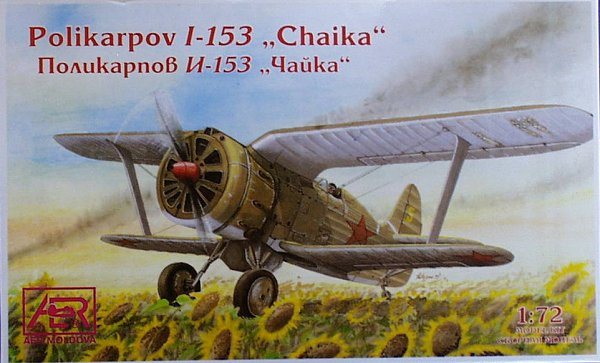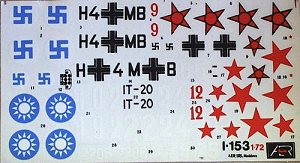
|
KIT: |
AER 1/72 I-153 |
|
KIT # |
7204 |
|
PRICE: |
$6 AUD |
|
DECALS: |
See preview |
|
REVIEWER: |
Mark Fordham |
|
NOTES: |
Short run kit |

|
HISTORY |
The most surprising thing about the I-153 is that it was not superseded by the I-16 monoplane, in fact the I-16 flew before the I-153 and I-15 and was in service before both and in 1939 actually replaced the I-16 in Mongolia because it was more agile. The I-153's and I-15's were mixed in with the I-16 equipped squadrons so the VVS had the best of both worlds, the higher speeds of the monoplanes with the agility of the bi-planes, in reality the I-153 was only a few miles per hour slower than the I-16 and far more maneuverable.
Many countries used the I-153 including the Finns, Chinese and even the Spanish Republics, all drawn to the types ruggedness and maneuverability, usually armed with four 7.62 ShKAS machine guns in the fuselage plus two 165lb bombs or six RS-82 rockets.
One of the most interesting modifications done to the I-153 was the addition of two ram jets under the wings in an attempt to boost the speed of the fighter for brief periods, in October 1940 a I-153 DM-4 (DM standing for "auxiliary motor") was clocked at a whopping 273 mph at 6,560 ft compared to the I-153's maximum speed of 241 mph.
|
THE KIT |

The AER I-153 "Chaika" is a model that I really wanted to add to my collection as I have for some reason seemed to have concentrated on Russian aircraft this last 6 months, it hasn't been anything planned it has just ended up turning out that way, The I-153 is one of three aircraft assigned to the "Kiwi connection" under the FBN Lend-Lease agreement and arrived in a sturdy packing crate with some assembly required.
Two trees of light grey plastic is the heart of the I-153 that were covered in so much release agent that I needed to wash the sprues just so I could keep hold of them. Sprue gates on the major parts are typically short run, being slightly on the thick side with a fair amount of flash around the wings, while on the subject of the wings, the underside of the top wing and the starboard lower were noticeably "short-shot" with about 1 mm of the trailing edge mal formed, note the red rings on picture.
Rib tape detail on the wings is reminiscent of 2x4 beams that would benefit from complete removal and replacement or at the very least it would need to be dramatically reduced by sanding and obtaining advice from the WWI fraternity on replacement wing tapes may be the order of the day here
Interior detail consists of a seat and control panel with a decal instrument panel, with the rest of the details supplied by the modeler, baring in mind that the I-153 was a simple aircraft and cockpit detail wouldn't be that hard to scratch.
Wheels, undercarriage and that unique engine cover are well molded but are marred with ejector pin marks, most noticeable on the front of the engine cover which look like they will be a kitty to hide.
The instructions are printed on a cheap A4 single sheet and apart from the color call-outs contain not one word of English, pictorial exploded construction steps and a mare 29 parts make for easy construction for those who cant read Russian.
 The decal sheet has marking
for no less than nine aircraft, six VVS aircraft using both types of Russian
stars, a German aircraft, a Finnish aircraft and finally a Chinese aircraft. Now
looking at the decal sheet I am confident that at the first hint of water the
decals will explode into a million pieces, I could be completely wrong but they
look like the sort that will, I will be coating the decals with a couple of
coats of liquid decal film just in case.
The decal sheet has marking
for no less than nine aircraft, six VVS aircraft using both types of Russian
stars, a German aircraft, a Finnish aircraft and finally a Chinese aircraft. Now
looking at the decal sheet I am confident that at the first hint of water the
decals will explode into a million pieces, I could be completely wrong but they
look like the sort that will, I will be coating the decals with a couple of
coats of liquid decal film just in case.
If you can get your hands on aftermarket decals for this little beast I would recommend that you do so, as the decals are printed slightly fuzzy.
|
CONCLUSIONS |
This is my first introduction to this manufacturer and from what is in the box the AER I-153 looks little rough and a touch simplistic in overall detail, yet with surface detailing resembling the finish of a Lada, the I-153 will need a fair amount of work to produce a decent model, but on the plus side it will be a value for money build as the kit doesn't cost the earth and has the basics to build on. A full build review is in the pipeline so stay tuned as I have just found a heap of Alpine collection photos of New Zealand's restored I-153.
|
REFERENCES |
Fighting Aircraft of World War II ISBN 1-84065-092-3
If you would like your product reviewed fairly and quickly where it will be seen by well over 150,000 visitors a month, please contact me or see other details in the Note to Contributors.